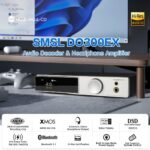In the ever-evolving world of technology, one term that continues to pique curiosity and generate endless discussions is DACs, short for Digital-to-Analog Converters. You’ve probably heard this term thrown around, but decoding its true meaning and significance can be a daunting task. Fear not, for this comprehensive guide is here to unravel the mysteries of DACs, shedding light on their importance, functionality, and how they shape our audio experiences. Get ready to embark on a journey where the digital realm meets the analog one, as we explore the fascinating world of DACs and their role in our everyday lives.
Understanding Digital to Analog Converters (DACs)
Digital to Analog Converters, commonly referred to as DACs, play a crucial role in the world of technology. Whether you’re listening to music, watching videos, or even driving a car, DACs are silently working behind the scenes to ensure the conversion of digital signals into analog form. In this comprehensive guide, we will explore the ins and outs of DACs, from their definition and importance to their various types, functionality, and much more. So buckle up and get ready to dive deep into the world of DACs!
Defining DACs
At its core, a Digital to Analog Converter (DAC) is an electronic device that transforms digital signals or data into analog signals. In simpler terms, it takes a series of ones and zeros, which represent digital data, and converts them into continuous electrical signals that can be easily understood by audio systems, displays, and other analog devices. In essence, DACs bridge the gap between the digital and analog worlds by recreating audio and other analog signals from digital information.
Importance of DACs
In today’s digital age, where digital media and technology are omnipresent, DACs have become an essential component in many consumer electronics. Whether it’s your smartphone, tablet, or multimedia player, DACs are responsible for converting the digitally stored audio files into analog signals, allowing us to hear music or watch videos with crystal clear audio. DACs are also used in communication devices, such as modems and routers, where they convert digital signals into analog for transmission over telephone lines. Thus, it’s safe to say that without DACs, our digital experiences would be lifeless and devoid of sound.
Functionality of DACs
To understand how DACs work, we need to trace the path of a digital audio signal. When you play a digital audio file, it is initially stored as binary code, consisting of a series of ones and zeros. This digital data is sent to the DAC, where it undergoes a conversion process. The DAC takes the binary data and reconstructs it into an analog waveform, which represents the original audio signal. This reconstructed analog signal is then amplified and sent to an audio device, such as a speaker or headphones, for us to enjoy.
Where DACs are used
DACs have a wide range of applications across various industries and products. In the consumer electronics realm, you can find DACs in smartphones, tablets, laptops, portable media players, and even gaming consoles. These devices rely on DACs to convert digital audio files into analog signals that can be heard through speakers or headphones. DACs are also found in televisions, projectors, and other display devices to convert digital video signals into analog for display on screens. Furthermore, DACs are used in car audio systems, home theater setups, and professional audio equipment to ensure accurate and high-quality analog audio reproduction.
Types of DACs
Now that we have a basic understanding of what DACs are and why they are important, let’s explore the different types of DACs available in the market.
Binary Weighted Resistor DACs
Binary Weighted Resistor DACs, often referred to as binary DACs, are one of the simplest and most common types of DACs. They utilize resistors of different weights to convert digital signals into corresponding analog voltages. Each bit of the digital input controls a specific resistor, and the cumulative effect of these resistors generates the analog output voltage. However, binary DACs suffer from poor accuracy due to the requirement of precise resistor values.
R-2R Ladder DACs
R-2R Ladder DACs, also known as R-2R DACs, are widely used in audio applications due to their simplicity and high precision. These DACs employ a network of resistors, with two distinct values (R and 2R), to generate analog output voltages. The 2R resistors act as a weighted summing network, while the R resistors are used as feedback resistors. R-2R ladder DACs offer improved accuracy and linearity compared to binary DACs.
String DACs
String DACs, as the name suggests, consist of a series of resistors arranged in a string-like structure. Each resistor in the string represents a specific voltage level, and by selectively connecting these resistors, the desired analog output voltage can be obtained. String DACs are commonly used in low-resolution applications due to their simplicity and cost-effectiveness.
Delta-Sigma DACs
Delta-Sigma DACs, also known as oversampling DACs, employ a sophisticated conversion technique to achieve high-resolution audio reproduction. These DACs use a combination of oversampling and noise shaping to convert digital signals into analog. Delta-Sigma DACs excel in minimizing distortion and noise, making them ideal for high-fidelity audio applications.
Working Principle of DACs
To truly understand the inner workings of DACs, let’s delve into their working principle and the process of digital to analog conversion.
Concept of Digital to Analog Conversion
Digital to analog conversion is the process of converting discrete digital data into a continuous analog signal. In the digital domain, data is represented in binary form, consisting of individual bits of ones and zeros. However, most real-world signals, such as audio and video, are continuous waveforms in the analog domain. DACs facilitate the transformation of digital signals into analog, enabling the faithful reproduction of the original signal.
Process of Conversion
The conversion process in a DAC involves multiple steps. Firstly, the digital input signal is sampled, which means that it is measured at regular intervals to capture its amplitude. The sampled data is then quantized into discrete levels based on the resolution of the DAC. The quantization levels represent the possible values that the digital signal can take on. Finally, the quantized samples are converted into analog voltages using various techniques, such as binary weighted resistors or R-2R ladders, which generate the continuous waveform that represents the original analog signal.
Understanding Bit-Resolution
Bit-resolution is a fundamental aspect of DACs that determines the accuracy and quality of the analog output. It refers to the number of bits used to represent the digital signal. A higher bit-resolution leads to a more precise conversion and a smoother analog output. For example, an 8-bit DAC can represent 2^8 (256) different levels, while a 16-bit DAC can represent 2^16 (65,536) levels. It is important to note that increasing the bit-resolution also increases the complexity and cost of the DAC, making it a crucial factor to consider in choosing the right DAC for a specific application.
Factors Influencing DAC Performance
While DACs are designed to faithfully convert digital signals into analog, several factors can impact their performance. Let’s take a closer look at some of the key factors that affect DAC performance.
Effect of Number of Bits
The number of bits in a DAC, also known as its bit depth, directly influences the resolution and accuracy of the analog output. Higher bit-depth DACs offer finer granularity and a larger dynamic range, allowing for more precise and faithful reproduction of the original signal. However, increasing the number of bits also increases the complexity and cost of the DAC, making it necessary to strike a balance between performance and practicality.
Sampling Rate
The sampling rate of a DAC is the number of samples taken per second from the digital input signal. It is measured in hertz (Hz). A higher sampling rate allows for a more accurate representation of the original analog signal, especially for higher frequencies. The most common sampling rate for audio applications is 44.1 kHz, which is the sampling rate used in audio CDs. However, higher sampling rates, such as 96 kHz or 192 kHz, are now widely used in high-definition audio formats.
Noise and Distortion
Noise and distortion are undesirable elements that can degrade the quality of the analog output. Noise refers to any unwanted signals or interferences that are introduced during the conversion process, while distortion refers to any alteration or modification of the original signal. Both noise and distortion can be caused by various factors, including electrical interference, component quality, and DAC design. Minimizing noise and distortion is a key challenge in DAC design and can significantly impact the overall performance and fidelity of the analog output.
Components of DACs
A typical DAC is composed of several components that work together to convert digital signals into analog. Let’s take a closer look at these components.
Converter Chip
At the heart of a DAC is the converter chip, which performs the actual digital to analog conversion. The converter chip takes the binary data from the digital input and generates the corresponding analog output voltage. The quality and design of the converter chip greatly influence the overall performance and accuracy of the DAC.
Output Stage
The output stage of a DAC is responsible for amplifying the analog signal to an appropriate level. This ensures that the analog output is strong enough to drive external devices, such as speakers or headphones, without degradation in quality. The output stage may also include filtering components to remove any noise or unwanted frequencies from the analog signal.
Power Supply
A stable and clean power supply is essential for the optimal performance of a DAC. The power supply provides the necessary voltage and current for the DAC to operate effectively. Any fluctuations or noise in the power supply can directly impact the analog output, leading to distortions or other unwanted artifacts.
Digital Buffering & Filtration
DACs often employ digital buffering and filtration techniques to enhance the accuracy and quality of the analog output. Digital buffering involves temporarily storing and smoothing out the digital input data, allowing for a more consistent conversion. Digital filtration, on the other hand, removes unwanted artifacts, noise, or frequency components from the digital input signal before converting it into analog.
Quality Measurement of DACs
The performance of a DAC can be assessed using various quality measurement metrics. Let’s explore some of the key parameters used to evaluate the quality of DACs.
Total Harmonic Distortion (THD)
Total Harmonic Distortion (THD) is a measure of the level of harmonic distortion present in the analog output. Harmonic distortion refers to the additional frequencies that are created by nonlinearities and imperfections in the conversion process. A lower THD value indicates less distortion and, therefore, higher audio fidelity.
Dynamic Range
Dynamic Range is the difference between the loudest and softest sounds that a DAC can reproduce without distortion. It quantifies the ability of the DAC to accurately reproduce both quiet and loud passages in an audio signal. A higher dynamic range is desirable as it allows for a greater level of detail and realism in the reproduced audio.
Signal-to-Noise Ratio (SNR)
Signal-to-Noise Ratio (SNR) measures the ratio of the desired signal to the background noise present in the analog output. A higher SNR indicates a cleaner and more accurate analog output, as the desired signal is more distinct from the noise floor. SNR is an important parameter, especially in high-fidelity audio applications, where background noise can significantly degrade the audio listening experience.
Channel Separation
Channel Separation, also known as crosstalk, measures the level of interference or bleed-through between different audio channels of a DAC. It quantifies the degree to which the left and right channels of a stereo audio signal are isolated from each other. Higher channel separation ensures a more distinct and accurate stereo image, allowing for a more immersive audio experience.
Challenges and Limitations of DACs
While DACs have revolutionized the way we experience digital media, they are not without their challenges and limitations. Let’s explore some of the key challenges associated with DACs.
Quantization Error
Quantization error is an inherent limitation of digital to analog conversion. It occurs when the continuous analog signal is approximated by discrete digital levels. The quantization process can introduce small errors, resulting in distortions or inaccuracies in the analog output. Minimizing quantization error requires increasing the bit-resolution of the DAC, which comes at the cost of increased complexity and cost.
Timing Jitter
Timing jitter refers to small variations in the timing or accuracy of the conversion process. It can lead to distortions or artifacts in the analog output, especially when dealing with high-frequency signals or rapid changes in the digital input. Minimizing timing jitter requires precise clocking mechanisms and can be a significant challenge in high-resolution or high-speed DAC designs.
Aliasing
Aliasing is a phenomenon that occurs when higher frequency components of the digital input signal are improperly reconstructed in the analog output. This can lead to audible artifacts, such as aliasing noise or distortion. Anti-aliasing filters are commonly employed in DACs to remove or attenuate unwanted high-frequency components before conversion to prevent aliasing.
Modern Trends in DACs
As technology continues to evolve at a rapid pace, DACs are also undergoing advancements and innovations. Let’s explore some of the modern trends in DACs.
Higher Resolution DACs
One of the most notable trends in DACs is the push for higher resolution. DACs with bit-depths of 24 or more are becoming increasingly common, allowing for finer granularity and improved audio accuracy. Higher resolution DACs enable the faithful reproduction of high-resolution audio formats, providing audiophiles and music enthusiasts with a more immersive listening experience.
Wireless DACs
With the growing popularity of wireless audio systems and streaming services, wireless DACs have gained significant attention. These DACs utilize wireless communication protocols, such as Bluetooth or Wi-Fi, to transmit digital audio signals to external speakers or headphones. Wireless DACs offer flexibility and convenience, allowing users to enjoy high-quality audio without the constraints of physical connections.
Integration with AI and IoT
The integration of DACs with artificial intelligence (AI) and the Internet of Things (IoT) is another emerging trend. AI-powered DACs can analyze and optimize audio signals in real-time, enhancing the overall audio quality and tailoring the sound output to suit individual preferences. Additionally, IoT-enabled DACs can seamlessly connect and interact with other smart devices, creating a more integrated and immersive audio ecosystem.
Choosing the Right DAC
With the diverse range of DACs available in the market, choosing the right one can be a daunting task. Let’s explore some key factors to consider when selecting a DAC.
Deciding Factors
When selecting a DAC, it’s essential to consider factors such as intended use, compatibility with existing devices, and the specific requirements of your audio setup. For example, if you’re an audiophile looking for high-fidelity audio reproduction, you may prioritize DACs with higher bit-depths and sampling rates. On the other hand, if you’re looking for a portable and versatile solution, a compact and wireless DAC may be more suitable.
Cost Vs. Performance
Price, of course, plays a significant role in the selection process. DACs come in a wide price range, and it’s essential to find the right balance between cost and performance. While higher-end DACs offer superior audio quality and additional features, they may not be necessary for everyone. Assess your requirements and budget to find a DAC that offers the best value for your needs.
Popular DAC Brands & Models
Several reputable brands offer a wide range of DACs, each with its unique features and capabilities. Some popular DAC brands include Audioquest, Chord Electronics, Schiit Audio, and Cambridge Audio. It’s always recommended to do thorough research, read reviews, and compare specifications before making a final decision. This ensures that you select a DAC from a reliable brand that aligns with your specific requirements.
Future of DACs
As we look ahead to the future, DACs are poised to play an even more significant role in our digital lives. Let’s explore some of the predicted developments and emerging tech trends in DACs.
Emerging Tech Trends
Advancements in semiconductor technology, such as the development of smaller and more power-efficient components, are anticipated to drive the miniaturization and integration of DACs into a wide range of devices. This trend will result in even more compact and portable DAC solutions.
Predicted Developments
The demand for high-resolution audio and immersive experiences is expected to fuel the development of even higher bit-depth DACs with increased frequency response capabilities. These advancements will provide audio enthusiasts with unprecedented audio accuracy and precision.
Impact of High-Resolution Audio Evolution
As high-resolution audio formats gain more traction among consumers, DACs will continue to play a crucial role in delivering high-fidelity audio experiences. The evolution of high-resolution audio, coupled with advancements in DAC technology, will revolutionize how we listen to music and consume audio content.
In conclusion, Digital to Analog Converters (DACs) are the unsung heroes of our digital age, enabling the conversion of digital signals into analog form for various applications. Whether it’s for listening to music, watching videos, or communicating over long distances, DACs ensure that we can experience high-quality audio and accurate analog output. By understanding the different types, functionality, working principles, and performance factors of DACs, we can make informed decisions when choosing the right DAC to enhance our digital experiences. With the ongoing advancements in technology and the predicted developments in the world of DACs, we can expect a future where audio reproduction reaches unparalleled levels of fidelity and realism. So, embrace the world of DACs and uncover the magic that lies within these essential devices!










